Cost of Installing a Heat Recovery System (MVHR)
Last updated 16th February, 2024
Want to know more about a heat recovery system?
If you wish to install a heat recovery sytem (MVHR), you can expect to pay £2,000-£8,000. This does depend on a few factors, which you'll discover by reading this detailed cost guide.
Keep reading for more information!
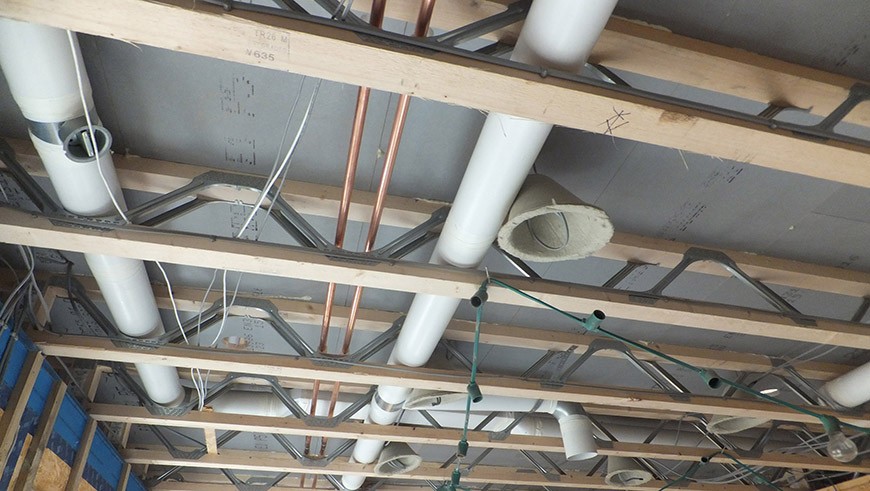
How Much Does a Heat Recovery System Cost?
The cost of a mechanical ventilation with heat recovery (MVHR) system will depend on several factors including the size of the property, the number of extract and supply points and the specific unit that is preferred.
The type of MVHR unit will also depend on the variation of the system used in relation to the heat exchanger. There are three possibilities: counter flow, cross flow, and rotary wheel.
Counter flow and cross flow are the most common kind used in domestic mechanical ventilation with heat recovery systems. Rotary wheel heat exchanger units are more typically used in commercial systems although there are some which are suitable for domestic installation.
The average price of a counter flow heat exchanger is between £2,000-£8,000. The cost will largely depend on the size of the unit, the brand and the specific features and functions that it carries out. Some will include intelligent controls with summer bypass and frost protection elements. In contrast, others are more basic and simply carry out the heat exchange between the extract and supply air flows. Your budget may determine which features are necessary.
Cross flow heat exchangers cost between £1,000-£2,500 on average and work in a similar way to a counter flow heat exchanger in that they both comprise of heat plates which funnel both stale and fresh air. Counter flow heat exchange units have air flows which travel in opposite directions and cross flow units incorporate air flows that traverse each other. However, in both instances, the opposing air flows never mix, and there is no contamination.
In domestic MVHR installations, rotary wheel units are not commonly used. This is because their design lends itself better to large installations such as in public buildings, hotels, or factories. There are some units which can be installed in domestic settings and these cost on average between £1,700-£3,500.
The cost of installing an MVHR system involves a design process which is essential for its successful operation. The average price for this service is between £450-£700. The proper design of the system will be crucial to the correct and effective process of the MVHR installation.
An average home of 250sqm will require around £2,250 in ducting, but this will depend on what type of ducting is used. There are several varieties and qualities available from flexi ducting to semi-rigid plastic and even galvanized metal.
The MVHR unit itself will cost on average £1,500-£3,500 although it will be dependent on the type and brand that you choose.
After the system is installed, it is mandatory to have it commissioned, which means a technician makes sure that it is working correctly and that the air flow to each room is as it should be. This is called balancing the system. The cost to commission an MVHR system is between £400-£800.
As a whole, the average cost to supply, fit and commission an MVHR system installation is between £5,500-£6,500.
The prices are for whole house installation, although it is possible to have single rooms served by individual units.
Heat Recovery System Prices
The table below indicates the average cost of various mechanical ventilation with heat recovery systems, including the heat exchanger, ducting and labour costs for design and installation. You should also account for the commissioning which will add around £400-£800 on the below total costs.
| Type | Unit | Design | Ducting | Installation | Total Cost |
|---|---|---|---|---|---|
| Counter flow | £3,500 | £550 | £2,250 | £2,000 | £9,000 |
| Cross flow | £1,500 | £550 | £2,250 | £2,000 | £7,000 |
| Rotary wheel | £2,500 | £550 | £2,250 | £2,000 | £8,000 |
Supply Costs
The below table gives an indication of the average cost of an MVHR unit only. This price does not include the ducting that will be necessary for the functioning of the system as this cost will depend on the size of the property and hence the amount of ducting required.
| Type of MVHR system | Price range | Average Cost |
|---|---|---|
| Counterflow Heat Exchange Unit | £2000-£8000 | £3,500 |
| Cross flow Heat Exchange Unit | £1000-£2500 | £1,500 |
| Rotary wheel Heat Exchange Unit | £1700-£3500 | £2,500 |
Additional Costs
In order to make the MVHR system as efficient as possible, it may be necessary to tackle other issues within the property. Unless you are building a passive house, then it is important to ensure that the building is as airtight as possible. This may involve installing loft insulation or triple glazed windows and doors.
Loft Insulation
The cost of installing loft insulation will depend on what material and method is being used. Blanket insulation will cost on average £5 per square metre while loose-fill insulation costs approximately £7 per square metre. Spray insulation is the most expensive and will cost around £70 per square metre.
Building Regulations require that insulation in the loft must be a minimum of 270mm deep.
Triple Glazing
Fitting triple glazed windows is a good way of improving the insulation of your home and saving energy. The average cost to install triple glazing is between £2,000-£7,000 depending on the size of the property and the number and style of windows fitted.
Solar Panels
As part of an energy-saving effort to make your home as efficient as possible, you may consider installing solar panels or solar roof tiles. Solar panels or photovoltaic (PV) panels convert sunlight into energy, allowing you to domestic power appliances from the stored energy.
Any excess can be exported back to the power grid. The cost to install solar panels ranges from £2,000-£9,000 depending on the number of panels fitted and the square meterage covered.
Solar Roof Tiles
Some people may prefer the slightly less intrusive and relatively new solar roof tiles. Although they are not as effective as traditional solar panels and more expensive, some people may prefer the more subtle look. The average cost to fit solar tiles is between £6,000-£13,000 depending on the size of the roof.
Cost Breakdown Calculator
Individual cost for the design, installation, and commissioning of a mechanical ventilation with heat recovery system in a three-bedroom house - £8,000
Materials
£4,800
Tradesmen
£2,800
Waste
£400
Labour Costs and Timeframes
The labour costs for the installation of a mechanical ventilation with heat recovery system will be divided between the physical fitting of the MVHR unit, associated ducting and electrical components and the labour cost for the design and commissioning of the system.
Design
Designing the MVHR system is crucial to its effective operation and successful installation. A site visit by the designer is preferable to constructing a design from plans or structural drawings alone.
Obviously, designing an MVHR system is easier for a new build then it would be for a refurbishment or retrofit, and the earlier it is done in the building design, the better. Re-routing electrics and plumbing is far easier than re-routing large ducting; therefore, forward planning and design is essential.
Depending on the complexity of the installation, the labour cost for designing the system can be between £450-£700.
Installation
An MVHR installation cost in the region of £2,000 is about average, but this will, of course, depend on the type of unit fitted and the amount of ducting that is needed.
Commissioning
Once installed, the MVHR system will need to be commissioned, and this service will cost in the region of £400-£800. This is a necessary post-installation procedure which ensures that the system is balanced and that each room in the house is getting the appropriate air flow.
Installation Timeframe
The average installation time for a mechanical ventilation with heat recovery system is two to three days. The exact timeframe will depend on the size of the property, the complexity of the installation and the experience of the contractor.
The easier installations are in newly built properties where there is a good design in place, and access is not a problem. Retrofits on older properties whilst not ideal are nevertheless possible although the job may take longer due to existing infrastructure that needs to be negotiated, and the labour costs will probably be higher.
Table of Contents
- How much does a heat recovery system cost?
- Labour costs and timeframes
- What is a heat recovery system?
- How does a heat recovery system work?
- Choosing a heat exchanger
- Purpose of an MVHR system
- How an MVHR system works
- What does installing a heat recovery system entail?
- Cost affecting factors of installing a heat recovery system
- Building regulations for a heat recovery system
- DIY heat recovery system
- Choosing a heat recovery system
- Benefits of a heat recovery system
- Removing a heat recovery system
- FAQs
- How to find & hire a heat recovery system installer
- Sources
What is a Heat Recovery System?
A heat recovery system or more precisely a mechanical ventilation with heat recovery system is a means of extracting warm air from a property whilst supplying fresh air from outside. Both streams of air pass through a heat exchanger and the incoming air is warm by the extracted air and pumped to the habitable rooms of the house. The extract air is pumped out of the building.
The ventilation is ‘mechanical’ as fans drive it as opposed to ‘natural’ ventilation which occurs due to differences in air pressure within a building. Examples of natural ventilation are opening a window or door.
Although the primary purpose of the system is to ventilate a home, the by-product of the process allows the heating of the supply air which means a reduction in heating demand and cost. The system provides improved indoor air quality which is beneficial to health and wellbeing.
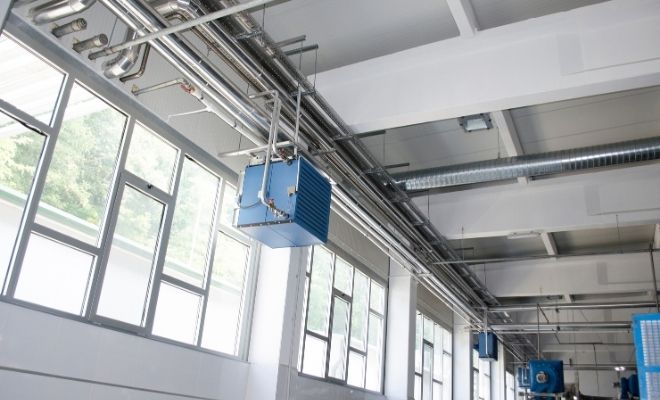
MVHR units have been around since the 1980s and have been refined and improved upon ever since. They have proven popular with passive house builders as well as other energy-efficient and low carbon buildings. Still, They can also be used in properties which are not specifically low energy.
One of the most beneficial factors of installing a mechanical ventilation with heat recovery system is the improved air quality. Air born allergens and pollutants are removed through filters within the MVHR unit itself and also within some of the air vents.
Cleaner air has obvious health benefits for allergy sufferers or those with a respiratory condition but is also beneficial to other occupants of the building. Good air quality is recognized as improving cognitive ability, concentration and aiding restful sleep.
How Does a Heat Recovery System Work?
An MVHR system extracts warm, humid air from the rooms in your property that produce it such as kitchens, bathrooms, wet rooms, or utility rooms while simultaneously pulling in fresh air from outside.
The two streams of air are passed through a heat exchanger which warms the incoming air, and this is then supplied to the habitable rooms of the house. The extracted and cooled air is vented outside. This is a balanced and continuous process.
The MVHR unit itself consists of a heat exchanger, fans, filters, inlet and outlets for the ductwork and a control unit.
Choosing a Heat Exchanger
There are three different types of heat exchanger: counter flow, cross flow, and rotary wheel.
Counter Flow Heat Exchanger Cost
The most common and efficient for domestic settings is the counter flow heat exchanger. It works by extracting the stale air through one set of ducting and pulling in fresh air through another; the two flows pass in opposite directions through the heat exchanger where the heat transfer takes place.
Cross Flow Heat Exchanger Cost
In a cross flow MVHR unit the flows of air pass perpendicular to each other through metal plates and the supply air is warmed by the heat of the extracted air and fed into the habitable rooms.
Rotary Wheel Heat Exchanger Cost
A rotary wheel heat exchanger works best with large volumes of air and is not often used in domestic heat recovery units. The process involves passing the extract and supply air streams through a rotating wheel which is a matrix of heat-absorbing material. The heat from the warm air is captured and as the wheel turns is transferred to the cold air supply.
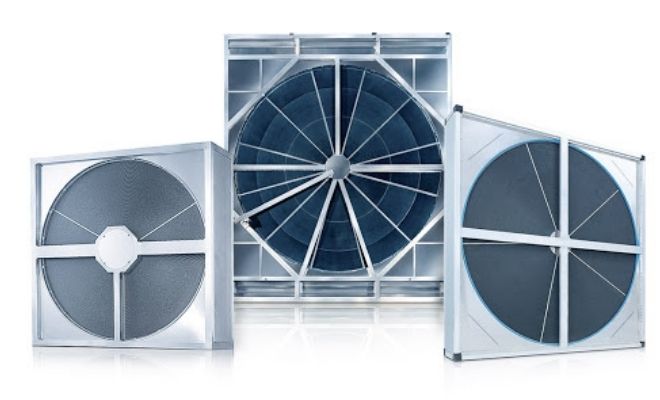
Purpose of an MVHR System
The MVHR system is primarily a ventilation system, not a heating system. The heat recovery is a consequence of the extraction of the warm, moist air which is put to good use by warming the supplied fresh air.
This process also removes pollutants from the air coming into the house such as pollen and similarly expels any indoor pollutants such as cooking odours via filters in the unit.
Different grades of filter will remove different pollutants. Although it seems odd to filter the extracted air that is being pumped out of the building, it is essential to keep the heat exchange unit clean and working efficiently.
How an MVHR System Works
An MVHR system combines a unit which moves air in and out of the property, filtering and heating it as it passes through a heat exchanger and pumping it via a network of ducting around the house.
One of the most important things to get right is the size of the MVHR unit. If it is not the right size for the property, it will cause problems. If it is too big, it will be inefficient and consume more power than is necessary and if it is too small, it will not perform its function and may well be noisy as it tries to compensate.

The unit should be sufficient for the number of rooms in the house as well as the number of occupants. This is why a proper design is so important.
The most invasive part of the MVHR system is the network of ducting that is required around the property. Getting the type of ducting right will also prevent excess noise and build of dirt in the system. If you have invested in a good quality unit, it is a false economy to buy cheap ducting and badly fitted ducting can also damage the MVHR unit.
This network takes the warm, humid air from the moist areas of the house such as kitchens and bathrooms and transports it to the MVHR unit where it passes through the heat exchanger. The supply air is similarly transported through the ductwork from outside the building to the heat exchanger and once warmed fed to the habitable rooms of the house.
What Does Installing a Heat Recovery System Entail?
The start point for installing a mechanical ventilation with heat recovery system is to contact a specialist familiar with its installation.
Designing the System
Whether you are building a passive house or retrofitting an existing property, it is vital for the optimal performance of your MVHR system that it is correctly designed and installed. Therefore, one of the first steps is for the contractor to conduct a site visit or use detailed structural drawings in order to design the system.
Some installers offer a free design service, and this is normally only a 2D basic design. Others provide a more detailed and 3D design which is preferable but will generally be chargeable.
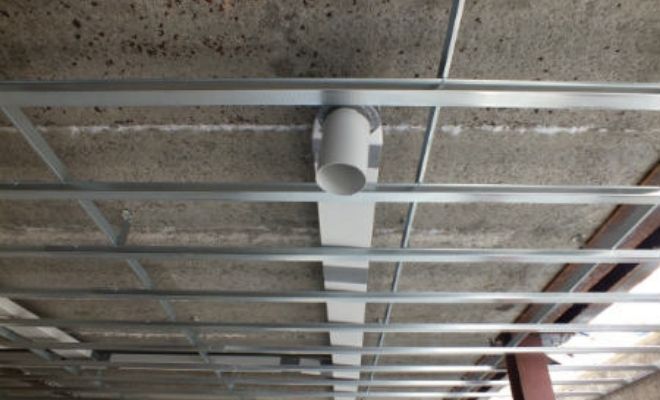
For a new build property, the ductwork for the MVHR system should be incorporated into the design at the earliest possible stage. This will allow the path of least resistance to be found for the ducting from the unit to the various extract and supply points within the house.
The logic behind this is to minimize the number of bends or junctions in the ducting, which will reduce the amount of air disturbance which can cause noise in the system. Therefore, the ducting should take priority over the routing of electrics and plumbing as wiring and pipework can be more readily diverted without impacting their function.
Installing the System
The installation of an MVHR system in a new build should be relatively straightforward, especially with a well-designed plan and a competent, experienced contractor.
Ducting
The ducting will ideally be fitted before the first fix electrics and plumbing following the most efficient route to the extract and supply valves to minimize air resistance and potential noise disturbance.
Routing ductwork between floors can be done through the timber stud work on new build properties if space allows. Routing through concrete will require boring through blockwork for access.
Ducting which runs through a cold space such as a loft must be insulated to prevent condensation forming on its exterior and potentially causing damage to the ducting or the fabric of the building. The insulation also improves the efficiency of the system.
Builders straps which are strips of flexible metal with holes for fixings can be used to secure the ducting to walls and ceilings. This can also be used to secure the manifolds which the ductwork runs into. The required air flow rate will dictate the size of the ducting.
Connections in the ducting should be done with an appropriate sealant and duct tape. This keeps the joint stable and prevents air leakage. Flexible ducting is not recommended under current Building Regulations for several reasons, including its air resistant nature which could adversely affect the operation of the system.
If it is necessary to include flexible ducting for access reasons, the maximum recommended amount is 300mm per leg of ducting.
Vertical ducting, which is taking extract air out of the building, should be fitted with a condensate trap to catch any moisture and prevent it from falling back onto the fan and causing damage. A condensate drain and trap are also needed on the MVHR unit for similar reasons.
Air Valves
The positioning of the extract and supply valves is important. Supply points in rooms should be located in draught free areas and externally exhaust points must be positioned at least 300mm from intake points to avoid re-entry of the extract air into the building.
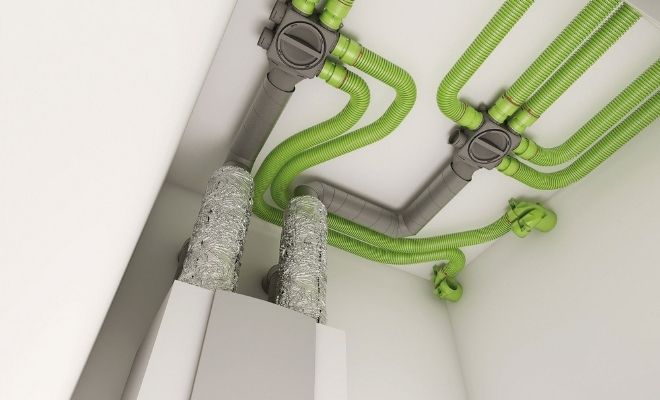
Heat Exchanger
If fitting the heat exchanger in a loft space, it is advisable to build a platform for the unit to sit on as this will allow ease of access for maintenance.
The positioning of the heat exchanger should be within the ‘thermal envelope’ which consists of the insulated walls and ceiling of the building. Minimizing the amount of ducting should also be a determinant in the siting of the heat exchanger, so a central location is advisable.
Control Unit
The MVHR control unit should be installed at second fix stage to avoid any damage if work is still going on in the property. For fixing to a wall ensure that the structure is strong and stable enough to support the unit.
Commissioning the System
Following full installation, the system must be commissioned to ensure that the air flow rates to each room achieve what is dictated by Building Regulations. Each room will have its own air flow rate, which will be determined by its volume.
Commissioning involves adjusting the speed of the fans within the unit and the positioning of the air valves in the supply points located in the ceiling. Ideally, the fans will be running as slowly as possible to mitigate noise disturbance while still achieving the required air flow to the room.
Once the air valves have met the expected air flow, they are locked off in the commissioned state and these settings are recorded in the commissioning certificate. This document should then be sent to the Building Control department of your local authority.
Retrofitting an MVHR system
Retrofitting an MVHR system will present problems with design as it will be necessary to fit the ducting around the existing utilities and infrastructure. It may also dictate the type of unit and ducting that you can realistically use, and this may restrict your choices.
Cost Affecting Factors of Installing a Heat Recovery System
MVHR cost will depend on several factors including which type of heat exchange unit you choose, the complexity of the installation, size of the property and the kind of ducting used.
Type of Unit
The type of heat recovery ventilation system that you choose to install will affect the price that you pay.
Counter flow heat exchangers are the most commonly used in domestic environments as they are the most efficient. As a result, there are many different variations on the market which range in price from, on average £3,000-£8,000.
A basic unit will consist of four inlet/outlet points, two fans, one for supply and one for exhaust, a heat exchanger with filters and a control unit. More high specification units have features such as built-in summer bypass, frost protection, Wi-Fi operation or pre-heaters.
Ease of Access
Each installation will have a unique design and layout. While new builds are the ideal situation for installing an MVHR system, there are other scenarios where it can be fitted.
Designing the system for a new property still in the early stages allows the maximum scope for positioning of the unit and the best possible layout for the ducting to the supply and extract points.
Similarly, with installation in a new build, there will be adequate and full access to the voids of the building to fit the ducting and unit without the need to work around existing infrastructure.
Retrofitting of a heat recovery ventilation system is not common, and issues with access for the ducting is the usual reason. Manoeuvring around joists, pipework and junction boxes is not only challenging and time-consuming but may also render the whole system inefficient.
Working around obstacles may involve more joins and bends in the ductwork, and that will impact on the airflow. Air resistance will mean that the fan in the heat recovery system will need to work harder to compensate; this can mean that the fan will create more noise and may be more expensive to run. In addition, the extra work of laying ducting in an existing property will mean more money in labour costs.
Efficiency and Hygiene
Optimizing efficiency depends on the length of the ducting system, the dimension and smoothness of the interior of the ductwork and the number and radius of the bends. All of these qualities help with the reduction of noise within the system and the hygiene of the ducting, which can impact on the air quality.
Choosing the type of ducting should be done with care as it is a permanent decision; it will be very difficult and disruptive to rectify a wrong choice based on cost.
Choice of Ducting
Choosing the most effective ducting will have a lasting impact on the performance of the entire MVHR system. The quality and design of the ducting is as important as that of the heat exchange unit, and both will affect the performance of the system.
Flexible Ducting
Flexible ducting is not recommended for use with a mechanical heat recovery system due to its ribbed interior, which creates air resistance and cannot be effectively cleaned. It is also easily crushed and torn. The average cost of 125mm flexible ducting is around £3-£5 per metre.
Semi-flexible Aluminium Ducting
This ducting is useful for manoeuvring around obstacles and fixtures but it is also prone to being crushed and damaged. The interior is not smooth and so not as efficient for air flow. Cleaning and hygiene would also be an issue with this type of ducting. The average cost of semi-flexible aluminium 125mm diameter ducting is around £6-£9 per metre.
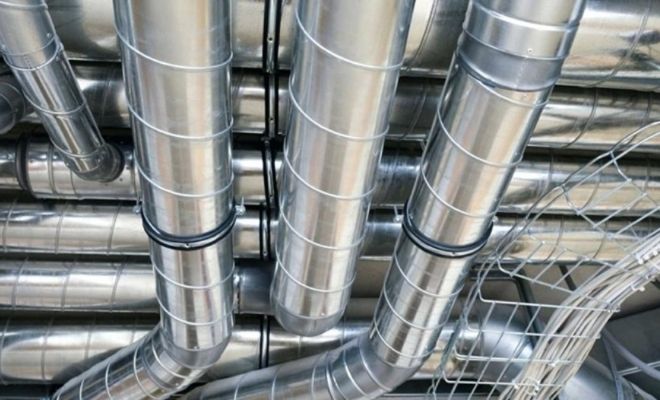
Rigid PVC Ducting
The advantage of rigid PVC ducting is that it will not be crushed or torn. However, the downside is that the bends tend to be quite sharp, which will impact on the air flow. This kind of ducting if not anti-microbial, can allow bacteria and mould growth in the interior of the ducting. The average cost of rigid PVC 125mm ducting is £5-£6 per metre.
Rigid Galvanized Ducting
This ducting is extensively used in commercial applications but has been adapted for domestic installations. It is a hygienic and efficient form of ducting but has the disadvantage of needing lots of connections and bends due to its rigidity. The average cost of rigid galvanized 125mm ducting is £5-£7 per metre.
EPE Ducting
EPE (expanded Polyethylene) foam ducting works against condensation formation by providing thermal insulation. It is easily trimmed to size and does not require adhesive or tape for joins which are made with special connectors. The average cost of EPE insulated 125mm ducting is approximately £10-£14 per metre.
A heat recovery ventilation system is only as good as the ducting that serves the rooms of the house. Poorly installed or cheap ducting will cause the whole system to under perform and may significantly impact the longevity of the MVHR unit. On the other hand, ducting, which is fit for purpose and installed correctly, will result in an efficient system that requires low maintenance.
Size of Property
As well as the type of ducting that is used in your MVHR system, the amount of ducting needed will also have a cost implication. This will be determined by the size of the property as will the specific MVHR unit needed to ventilate the whole house. Of course, the number of rooms will also determine the number of supply air valves that will be required.
The average cost of air supply and extract valves is between £5-£10 depending on whether they are plastic or metal.
Airtightness of House
Mechanical ventilation with heat recovery systems was once thought to only be worthwhile in a passive house or similar, but this is not necessarily the case. While it is true that the more airtight the building, the more efficient the system will be this does not mean that it cannot be installed in a regular home.
As long as it is coupled with good insulation and successful action against air leakage, then an MVHR system can provide adequate air quality and cost-effective heat recovery.
Location of Property
As with most aspects of home improvement where you live will impact on the price that you pay for services, contractors, and materials. Large cities will always command higher costs, and this is especially true for the capital.
Owning and maintaining a home in London and the south-east of the UK will always be more expensive than other parts of the country due to the higher cost of living.
Retrofitting MVHR
Installing a heat recovery ventilation system in an existing property will inevitably throw up issues. Finding space in an existing loft space for ducting and improving the air tightness of an older property are just two problems that may be encountered.
Both of these will demand time and labour to overcome, and of course, this will cost more than a straightforward installation in a new build property.
Building Regulations for a Heat Recovery System
In 2010 ventilation of a domestic property became notifiable works under Building Regulations, and this includes MVHR systems. As such, it should be installed by a competent person and will need to be signed off by the Building Control department of your local authority.
The guidelines state that following installation, all mechanical ventilation systems that can be adjusted and tested must be commissioned and the commissioning notice sent to Building Control. For mechanical ventilation systems installed in new build, air flows must be measured on-site, and the notice sent to Building Control.
The owner of the property should receive a copy of the commissioning certificate, which confirms that the system complies with the relevant Building Regulations. This should be received no later than thirty days following installation.
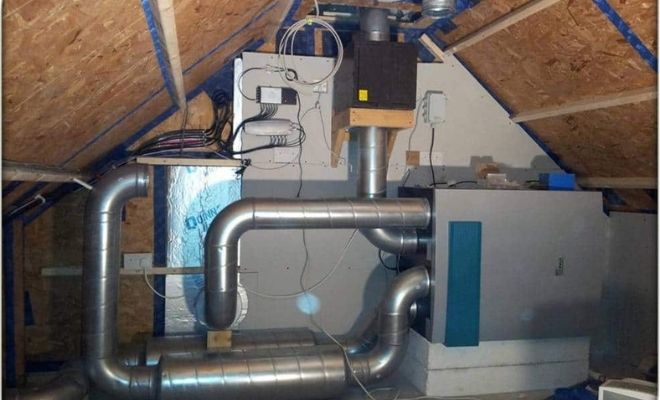
The guidelines also instruct installers that property owners must be given sufficient instruction on the maintenance of the MVHR system to ensure it provides adequate airflow.
Fees for Building Control will vary from one local authority to another, and you will need to contact them to find out how much you need to pay. If you are employing a contractor to carry out the installation for you, then they can submit the paperwork for you, and this means that there is no separate fee to pay to Building Control.
Information and fee amounts can be found at your local authority’s Building Control department or by speaking to your MVHR system installer.
DIY Heat Recovery System
A mechanical ventilation with heat recovery system can be installed as a DIY project, and indeed some systems are sold as DIY kits. The kits include a heat recovery unit, controller, ducting, supply and extract vents, plenum boxes and adjustable air valves.
Dangers of DIY Installation
One of the dangers of doing the installation yourself may be that you buy a kit for a three-bedroom house, for example. Still, each house will have differing recommended air flow rates according to room sizes and the number of occupants. How confident are you of assessing these factors in your home?
Another important consideration when fitting an MVHR system is the ducting which will feed the rooms with filtered and warmed air and remove the moist, stale air from the house. Knowing the correct diameter of ducting is essential to make sure the system works as it is intended.
Of course, if you buy a complete kit, the ductwork should be compatible with the heat exchanger, but if you purchase items separately, you need to ensure that the components fit together. The use of adaptors may disrupt air flow and introduce noise to the system.
You will also need to ensure that the runs of ductwork minimalize bends and junctions to reduce air resistance which can impede the system and create noise disturbance.
The location of the heat exchange unit should be chosen to keep the duct runs as short and straight as possible. A central position in the house either in a utility room or in the loft is often chosen for this reason.
However, be aware that the unit and ducting should be insulated in cold spaces such as lofts to prevent condensation. Units can be wall-mounted or free-standing; either way, access should be sufficient to allow for maintenance and changing of filters.
While there are heat recovery ventilation system pros and cons to consider if you buy a generic kit, you may not benefit as much as you anticipate.
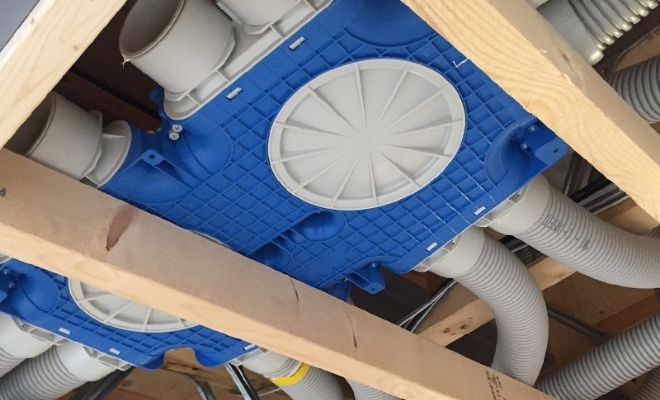
Air Leakage
Newly built homes in the UK must now have an air tightness test, and Building Regulations (Part L) require that all new homes be tested for air permeability as part of fuel and power conservation. This permeability means that no more than 10m³ of air should pass through a square metre of the building per hour at 50 pascals which is the equivalent of a light breeze blowing against the house.
Existing properties are unlikely to be as air tight as newly built homes. Therefore, any installation of an MVHR system must allow for the air leakage of such a property but is this something that can be gauged by a DIY enthusiast?
Of course, you could engage the services of a specialist to advise and design a mechanical ventilation with heat recovery system for you and carry out the installation yourself. The amount you would save on installation labour is on average £1,000-£3,000.
Post Installation Commissioning
Following installation, it is a requirement under Building Regulations that the system is commissioned. This means that it is taken from an installed, static state to fully operational and meeting air flow rates for the various rooms in the house. A qualified person should do this as the commissioning notice will need to be sent to Building Control to be signed off and a completion certificate issued.
Tools Required for DIY Installation
If you do carry out the installation yourself you will need:
- Electric drill
- Various screwdrivers
- Measuring tape
- Fine tooth saw
- Appropriate sealant
- Duct tape
Personal Protection Equipment
Safety equipment is advised for all home improvement work and includes:
- Gloves
- Safety goggles
- Safety boots
- Dust mask
Choosing a Heat Recovery System
There are three main types of heat exchanger which are a central component of a mechanical ventilation with a heat recovery system. These variations of heat exchanger are counter flow, cross flow, and rotary wheel and the MVHR system cost will depend on which one you choose.
Counter Flow Heat Recovery System Cost
A counter flow unit has supply and exhaust air entering the heat exchanger from opposite sides, and although they traverse the heat exchange plates, they never physically meet. On average, 75%-90% of the heat from the extract supply is recovered and transferred to the supply air.
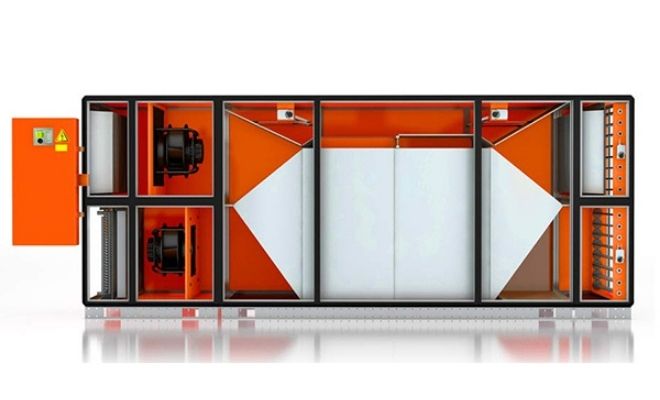
Pros
- ✔ Air quality is maintained as the supply and exhaust flows never mix.
- ✔ Most efficient method of recovering heat with up to 90% recovery.
- ✔ Low-pressure drop as air travels through the heat exchanger.
Cons
- ✖ More expensive than other heat exchange units.
- ✖ Configuration of heat exchange plates means units are often larger than cross flow.
- ✖ Condensation can be a problem, so drainage pipes and traps are needed.
The average cost of a counter flow heat exchange unit for mechanical ventilation with heat recovery is between £2,000-£8,000 depending on specification.
Cross Flow Heat Recovery System Cost
A cross flow heat exchanger allows the supply and extract air flows to cross perpendicular to each other. They are separated by aluminium plates which transfer the heat from one side to the other.
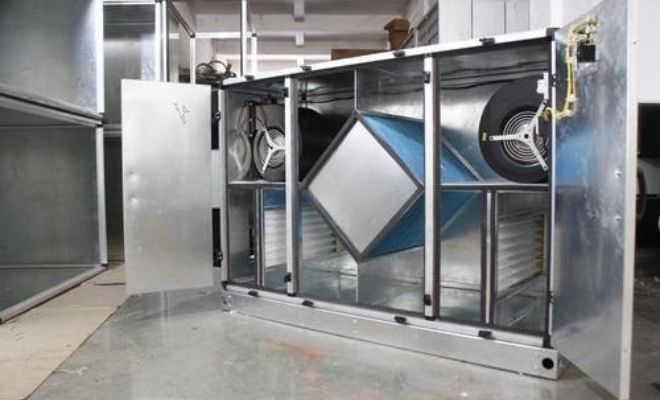
Pros
- ✔ The extracted air does not contaminate the fresh air supply.
- ✔ Efficiency of up to 75% for heat recovery.
- ✔ Not as expensive as counter flow heat exchange units.
Cons
- ✖ Lower heat recovery than a counter flow heat exchanger.
- ✖ Future thermal efficiency requirements could make these units redundant unless improved.
The average cost of a cross flow heat exchange unit for mechanical ventilation with heat recovery is £1,000-£2,500.
Rotary Wheel Heat Recovery System Cost
A rotary wheel heat exchanger operates by picking up the exhaust air in its aluminium matrix and transferring the heat to the supply air as it rotates.
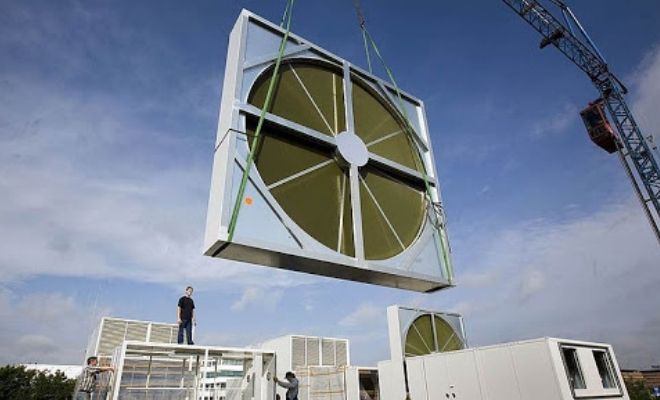
Pros
- ✔ Can handle large volumes of air.
- ✔ Efficiency of up to 85%.
- ✔ Aluminium rotary wheel heat exchangers last a long time.
Cons
- ✖ Risk of contamination of supply air from exhaust air as no separation.
- ✖ More useful in commercial and industrial settings.
- ✖ Due to moving parts, the risk of break down is greater.
The average cost of a rotary wheel heat exchange unit for mechanical ventilation with heat recovery is £1,500-£3,500.
Benefits of a Heat Recovery System
There are many benefits to having a mechanical ventilation with heat recovery system installed.
Energy Efficient
For someone who is building a new house, the most important factor to be considered is the energy efficiency of the home. There are various reasons for this; the cost of energy, whether it is electricity or gas, the impact on the environment and the need to comply with increasingly stringent Building Regulations in relation to energy efficiency.
An MVHR system offers low energy usage with thermal efficiency, and so it is an attractive option.
Cost-Effective
With heat recovery rates of between 50%-90%, it is clear that there is a cost benefit in fitting these heat recovery systems. However, the efficiency rates of the various heat exchange units must be seen in the context of the installation, commissioning, maintenance, and individual building air tightness.
As a stand-alone figure, the efficiency percentage only indicates what the heat exchange unit is capable of under optimum conditions. Nevertheless, the heat recovered by the system would otherwise be lost and the energy used to produce it wasted.
Eco Friendly
Arguably the most eco-friendly of buildings is a passive house, and mechanical ventilation with heat recovery is the most commonly used system in these homes. They work at their most efficient in air tight homes and recovering more than 90% of heat means that space heating and cooling requirements are dramatically reduced along with their associated costs and emissions.
Health Benefits
One of the key benefits of an MVHR system is an improvement in the air quality in the home. It is widely recognized that the air within a building can affect the welfare of the occupants in both their physical and cognitive health.
Pollutants and contaminants such as pollen are also removed, increasing the comfort of those suffering from allergies. Better air quality through the use of filters also reduces the effects of asthma and other respiratory conditions.
Removing a Heat Recovery System
Dismantling and removing your MVHR system will mean uninstalling the heat exchanger, ducting, and the control unit. The electrical elements should be done by a qualified electrician or heat recovery specialist but the other parts of the system could be removed as a DIY job.
Removing the ducting may take some time and care as it will be distributed throughout the house often within the fabric of the building.
Why Remove an MVHR System?
One of the reasons for removing an MVHR system could be that due to a bad installation, it is not performing as the homeowner expected. If the installation has been a poor one, it could also be noisy in operation and causing disturbance.
This is why it is important to have a specialist with experience fit the heat recovery system and why good quality components should be used. Cutting costs by using inferior ducting, for example, is a false economy and will result in low efficiency and noisy operation.
You may want to remove an existing MVHR system and replace it with a newer or more efficient variation.
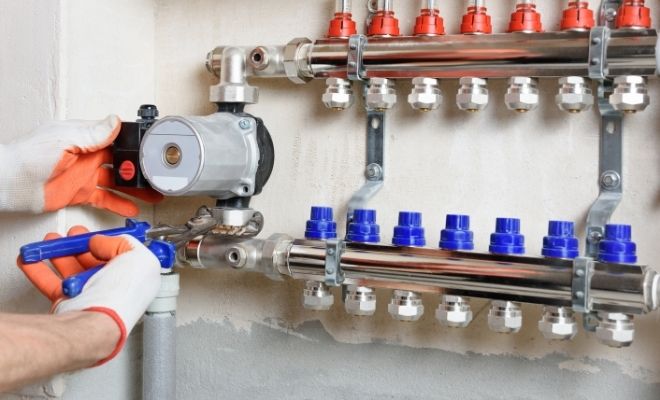
Cost of removing a MVHR system
A specialist contractor will charge to remove the heat recovery system. Still, as each installation is different, it is difficult to give a precise cost for removal, and you should ask for a quotation.
The price for installation is approximately £2,000 so you may be able to calculate from this what a specialist would charge for dismantling and removing the system
You could hire a general builder to remove the MVHR system for you, and this may cost between £150-£250 a day as well as the cost of a skip if needed. The average cost of hiring a skip for a week is £200-£300.
Disposal
If you hire a contractor to remove the MVHR system for you, then you can negotiate for them to dispose of the elements that are not salvageable. You can check with your local recycling centre about which parts of the system can be disposed of there.
There are companies which offer disposal services for old electronic or mechanical items, so this may be worth considering, and there are scrap metal merchants who may pay for some of the parts.
FAQs
Negotiating other utilities such as plumbing and electrics may dictate a type of ducting that may not be your preferred choice such as flexible or rectangular. Efforts to reduce air leakage in an existing house should also be undertaken to optimize the performance of the MVHR system.
How to Find & Hire a Heat Recovery System Installer
Installing a ventilation system of any kind is notifiable works and as such should be carried out by a competent person. There are many specialist contractors who fit mechanical ventilation with heat recovery systems; however, it is advisable to use a company that has been in operation for a while, and that has been recommended.
You can ask for details of other installations that the installer has undertaken and ask questions such as which units they recommend, the best type of ducting or what problems could be encountered with the installation.
Qualifications
There are qualifications in MVHR installation available from NICEIC (National Inspection Council for Electrical Installation Contracting) and BPEC (British Plumbing Employers Council) and competent members schemes recognize these qualifications do they offer?
When considering installation of an MVHR system, it is worth having discussions with and quotations from three or four specialist companies. It will then be possible to differentiate not only between the prices quoted but also the services offered.
Be wary of installers who offer a free design service as a proper design is half the requirement of an efficient system. A free design service is not going to go into great depth and detail as it involves time, labour, and money, none of which professional companies give away for free.
Insurance
Of course, your MVHR installation contractor should have all the appropriate insurance such as public liability, professional indemnity, etc.. and you can ask to see proof of this prior to any work being done in your home.
Sources
https://www.passivhaustrust.org.uk/
https://energysavingtrust.org.uk/future-homes-housing-over-next-20-years/










